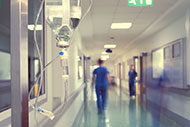List of most-challenging requirements released
The Joint Commission recently released a list of its Top 5 requirements identified most frequently as “not compliant” during surveys and reviews from Jan. 1 through Dec. 31, 2017. For hospitals, the top challenges in the life safety and environment of care areas were: providing and maintaining systems for extinguishing fires; managing risks associated with utility systems; providing and maintaining building features to protect individuals from the hazards of fire and smoke; and establishing and maintaining a safe, functional environment. In the infection control area, hospitals also struggled with reducing the risk of infections associated with medical equipment, devices and supplies. Many of the same or similar challenges were reported by critical access hospitals (CAHs), with inspecting, testing and maintaining medical gas and vacuum systems being a Top 5 challenge unique to CAHs.
CDC urges aggressive action to stop germ spread
The Centers for Disease Control and Prevention (CDC) recently urged state and local health departments and health care facilities to work with its Antibiotic Resistance Lab Network to implement a coordinated strategy to prevent the spread of unusual germs that are resistant to all or most antibiotics or can spread their resistance to other germs. More than 220 instances of such germs were reported in the United States last year. The strategy calls for rapid identification of resistance, infection control assessments, testing patients who are without symptoms but are possibly spreading the germ, and continued infection control assessments until the spread is stopped. “CDC’s study found several dangerous pathogens that can cause infections that are difficult or impossible to treat,” said CDC Principal Deputy Director Anne Schuchat, M.D. “It’s reassuring to see that state and local experts, using our containment strategy, identified and stopped these resistant bacteria.”
Hospitals participate in preparedness exercise
More than 50 organizations, including hospitals, participated in an exercise last month to test the nation’s ability to move patients with highly infectious diseases to regional treatment facilities, according to the Department of Health & Human Services. During the exercise, seven people acting as patients with Ebola symptoms presented at five hospitals. Health care workers shipped samples to state laboratories for testing, and prepared to transport a pediatric patient by ground to Texas Children’s Hospital West Campus in Houston, as well as six patients by air to regional Ebola treatment centers at Cedars-Sinai Medical Center in Los Angeles; Emory University Hospital in Atlanta; Providence Sacred Heart Medical Center in Spokane, Wash.; and the University of Texas Medical Branch in Galveston. Participants later shared best practices.
NFPA accepting comments on 101 and 99
The National Fire Protection Association (NFPA) is seeking public input on the next editions of two key documents for health care facilities: NFPA 101, Life Safety Code, and NFPA 99, Health Care Facilities Code. NFPA 101 is a source for strategies to protect people based on building construction, protection and occupancy features that minimize the effects of fire and related hazards, while NFPA 99 establishes criteria for levels of health care services or systems based on risk to patients, staff or visitors in health care facilities to minimize the hazards of fire, explosion and electricity. Comments can be submitted through June 27.





